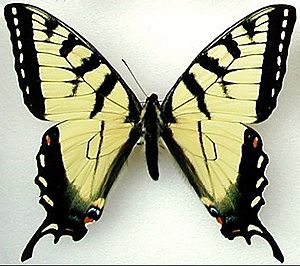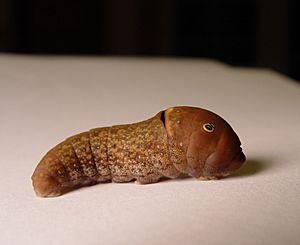Appalachian tiger swallowtail facts for kids
Quick facts for kids Appalachian tiger swallowtail |
|
|---|---|
 |
|
| Male holotype | |
| Scientific classification | |
| Kingdom: | |
| Phylum: | |
| Class: | |
| Order: | |
| Family: | |
| Genus: |
Papilio
|
| Species: |
P. appalachiensis
|
| Binomial name | |
| Papilio appalachiensis (Pavulaan & D. Wright, 2002)
|
|
| Synonyms | |
|
|
The Appalachian tiger swallowtail (Papilio appalachiensis) is a type of swallowtail butterfly. You can find it in eastern North America, especially in the Appalachian Mountains. This butterfly is special because it's a hybrid. This means it's a mix of two other Papilio species: the Canadian tiger swallowtail and the eastern tiger swallowtail.
Appalachian tiger swallowtails are usually yellow with black stripes on their wings. Their wings can spread from about 86 to 115 millimeters wide. The caterpillars of this butterfly can be green, yellow, or orange. They have black spots that make them look like bird droppings or a big eye. This helps them hide from animals that might want to eat them.
These butterflies have one generation per year. The females lay their eggs in May.
Contents
About the Appalachian Tiger Swallowtail
What is a Hybrid Butterfly?
The Appalachian tiger swallowtail is part of the Papilio group of butterflies. Scientists believe it formed from two other Papilio butterflies: the Canadian tiger swallowtail and the eastern tiger swallowtail.
Originally, these two parent species lived in different areas. But over time, their living areas started to overlap. This led to them breeding together and creating the new hybrid species, P. appalachiensis.
It's often hard for new hybrid species to survive. They need to find a new home that's different from their parents. The Appalachian tiger swallowtail found its own special place. It lives at higher elevations in the Appalachian Mountains. This helps it stay separate and unique.
Where Do They Live?
You can find the Appalachian tiger swallowtail in the eastern United States. They live in the Appalachian Mountains, from Pennsylvania all the way down to Georgia. These butterflies are bigger than both their parent species.
They love to gather in woodlands and open areas within forests. They prefer to stay in the middle to high parts of the southern Appalachian Mountains. While they are very common at high elevations, you can sometimes find them in lower areas too. Adult butterflies often stay high up in the trees. They usually only come down to visit flowers for nectar.
Appearance of the Appalachian Tiger Swallowtail
The Appalachian tiger swallowtail looks a bit like both its parent species. It likes cooler temperatures and has only one group of offspring per year. This is similar to the Canadian tiger swallowtail. It also has a dark female form that can mimic other butterflies, like the eastern tiger swallowtail.
Female Appalachian tiger swallowtails are usually bigger than eastern tiger swallowtail females. Their wings are a bit angular. The black stripes on their wings are thinner than those on the eastern tiger swallowtail. The spots on their hindwings are more rectangular, not as curved. Male hindwings tend to be more triangular.
Female Appalachian tiger swallowtails come in two colors: yellow and black. Both forms have a slight blue color on the top of their hindwings. This blue is not as strong as the blue on other tiger swallowtails. There is also a large orange spot on the top of the hindwing. Their wingspan is about 86 to 115 mm.
The Caterpillar Stage
The caterpillars of Papilio butterflies are smooth. They can be green, yellow, or orange. They have black markings that help them look like bird droppings. This is a great way to hide from predators. They also have markings that look like big "eyes." These "eyes" are yellow rings with black, and a smaller purple spot inside. A small black spot on top makes it look even more like a real eye. This kind of mimicry helps protect them from animals that might want to eat them.
Swallowtail caterpillars also have a special defense. They have a scent gland called an osmeterium behind their head. If something bothers them, this gland pops out and releases a bad smell. The gland is orange-red and looks like a fork. This, along with their "eyes," makes the caterpillar look like a snake. This helps scare away predators.
The caterpillar builds a nest by folding a leaf over itself and holding it together with silk. When it's ready to change, it can be up to 5 cm long. It takes about a month for an egg to become an adult butterfly. Fully grown caterpillars are usually green. After hatching, the caterpillar often eats its own eggshell.
Caterpillars are known to eat the leaves of the black cherry tree.
Life Cycle and Habits
Life Cycle
The Appalachian tiger swallowtail has one generation each year. Female butterflies usually lay their eggs from May to June. During mating season, males fly through the tops of trees looking for females. Females often hide in the forest canopy, making them hard to find.
After mating, females lay single eggs on the leaves of host plants. The caterpillars hatch and eat these leaves. Then, they form a chrysalis (pupa) and spend the winter in this stage. The pupae stay in a resting state until spring. The adult butterflies emerge in May.
What Do They Eat?
Adult butterflies drink nectar from many different flowers. Some of their favorite plants include the mountain laurel, pink azalea, blackberry, and multiflora rose. At higher elevations, they also drink from the autumn olive. At lower elevations, they like the daisy fleabane.
The caterpillars eat the leaves of various trees. These include cottonwood, tulip tree, lemon, and cherry trees.
How Do They Fly?
The Appalachian tiger swallowtail flies from May to early June. Some individuals might fly later in June. These butterflies can migrate over 200 kilometers each year.
They tend to fly directly up the western side of Spruce Knob towards the top, even against strong winds. The top of Spruce Knob has sheltered spots with lots of plants. Here, the adult butterflies can rest and drink nectar.





